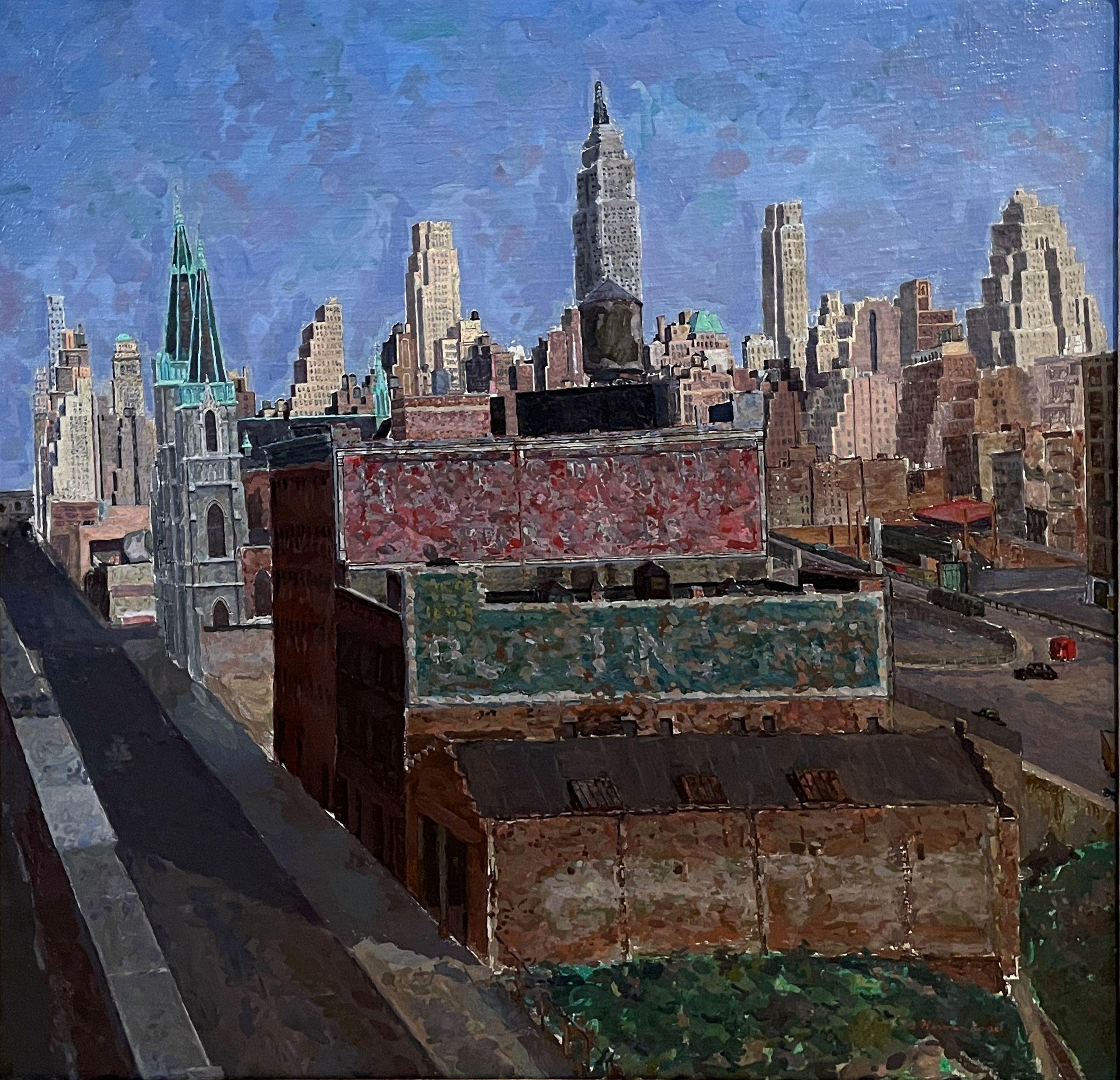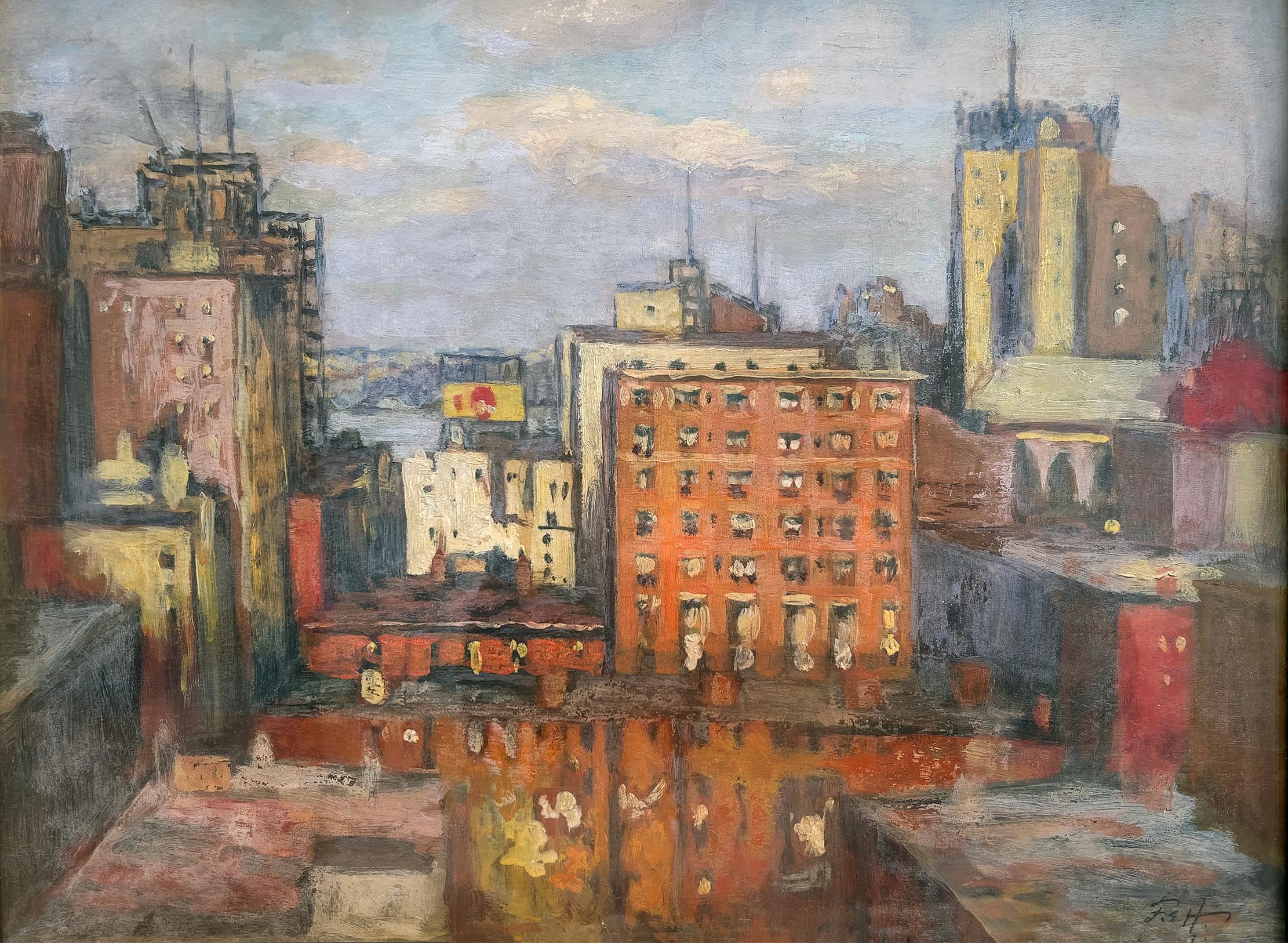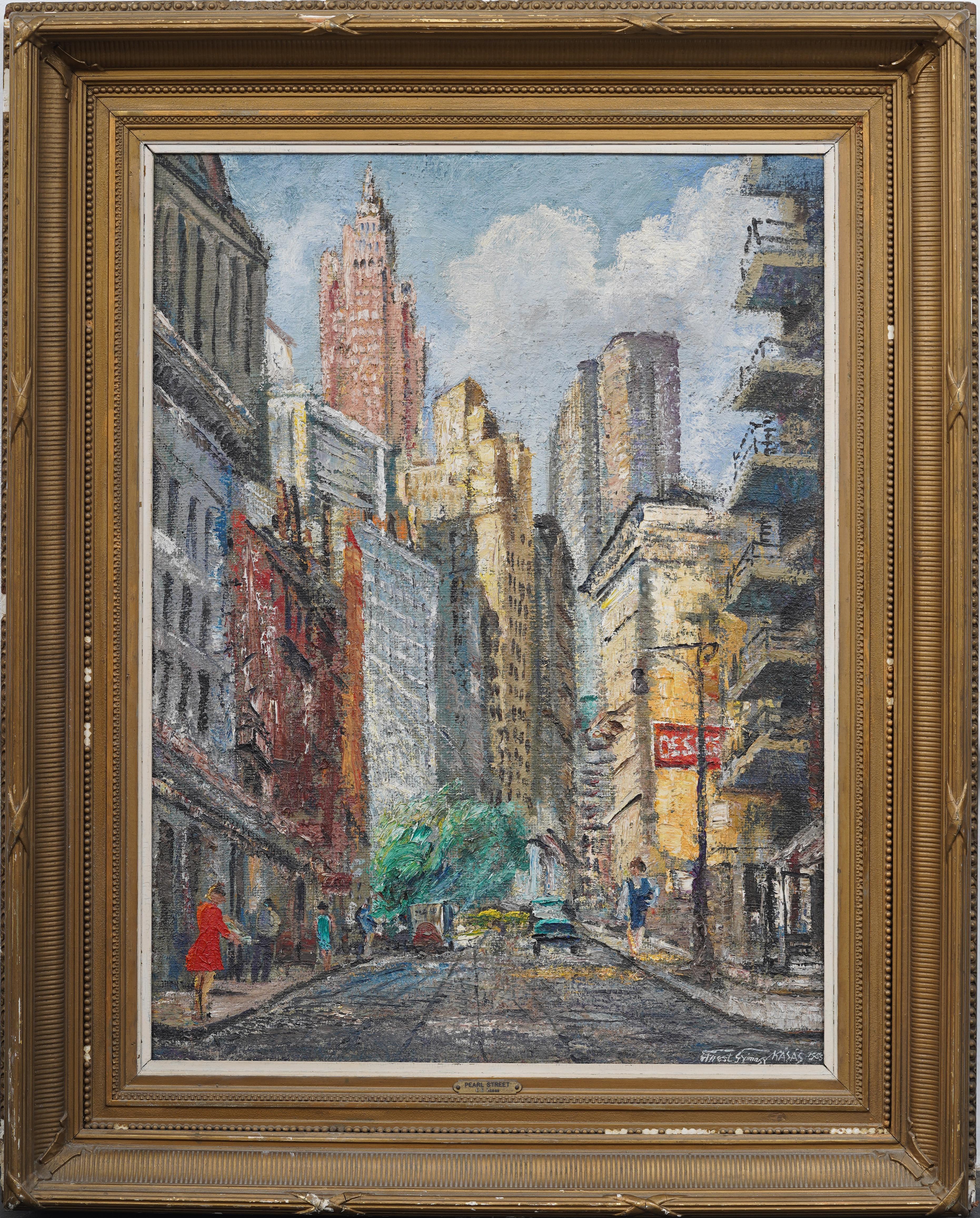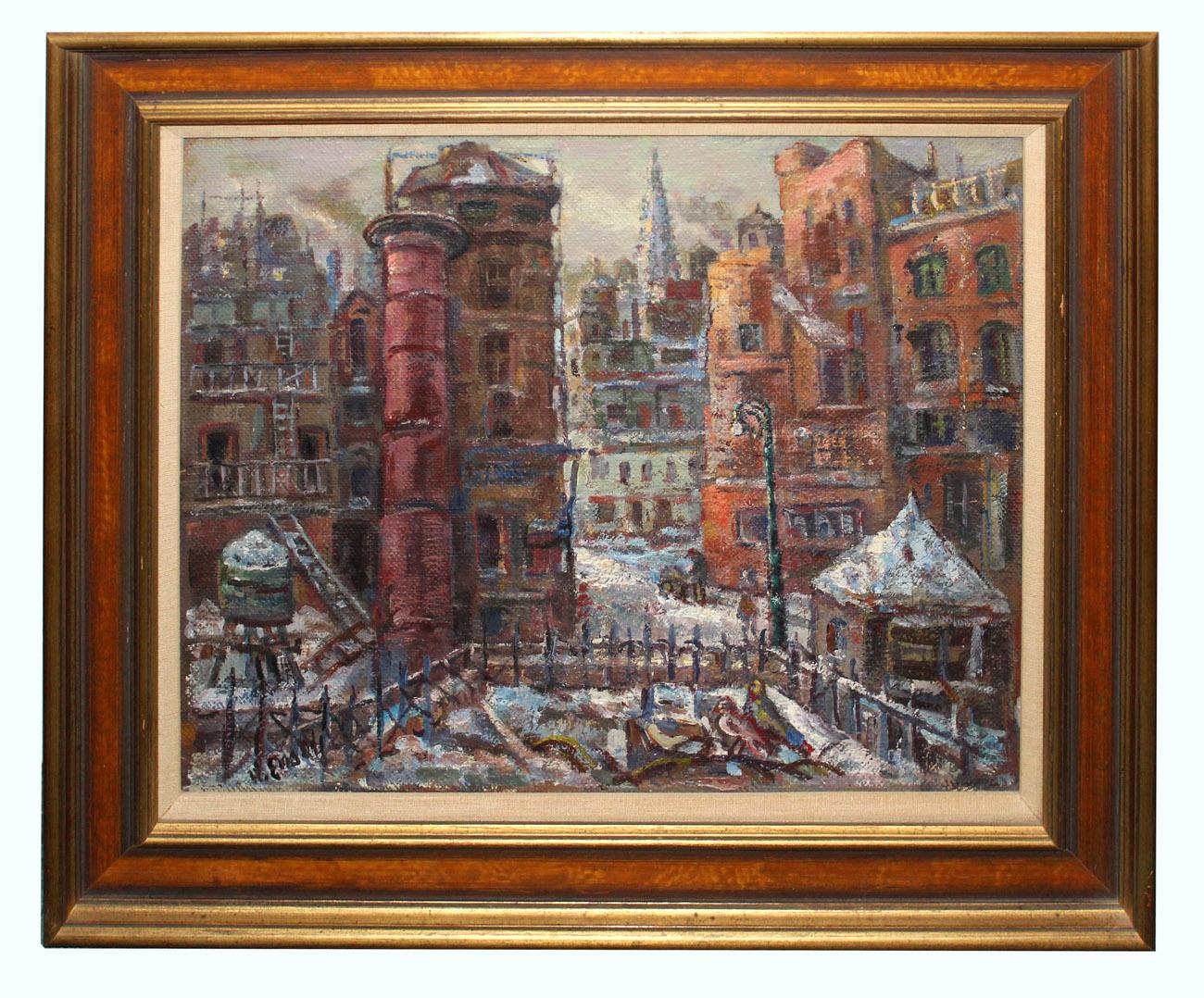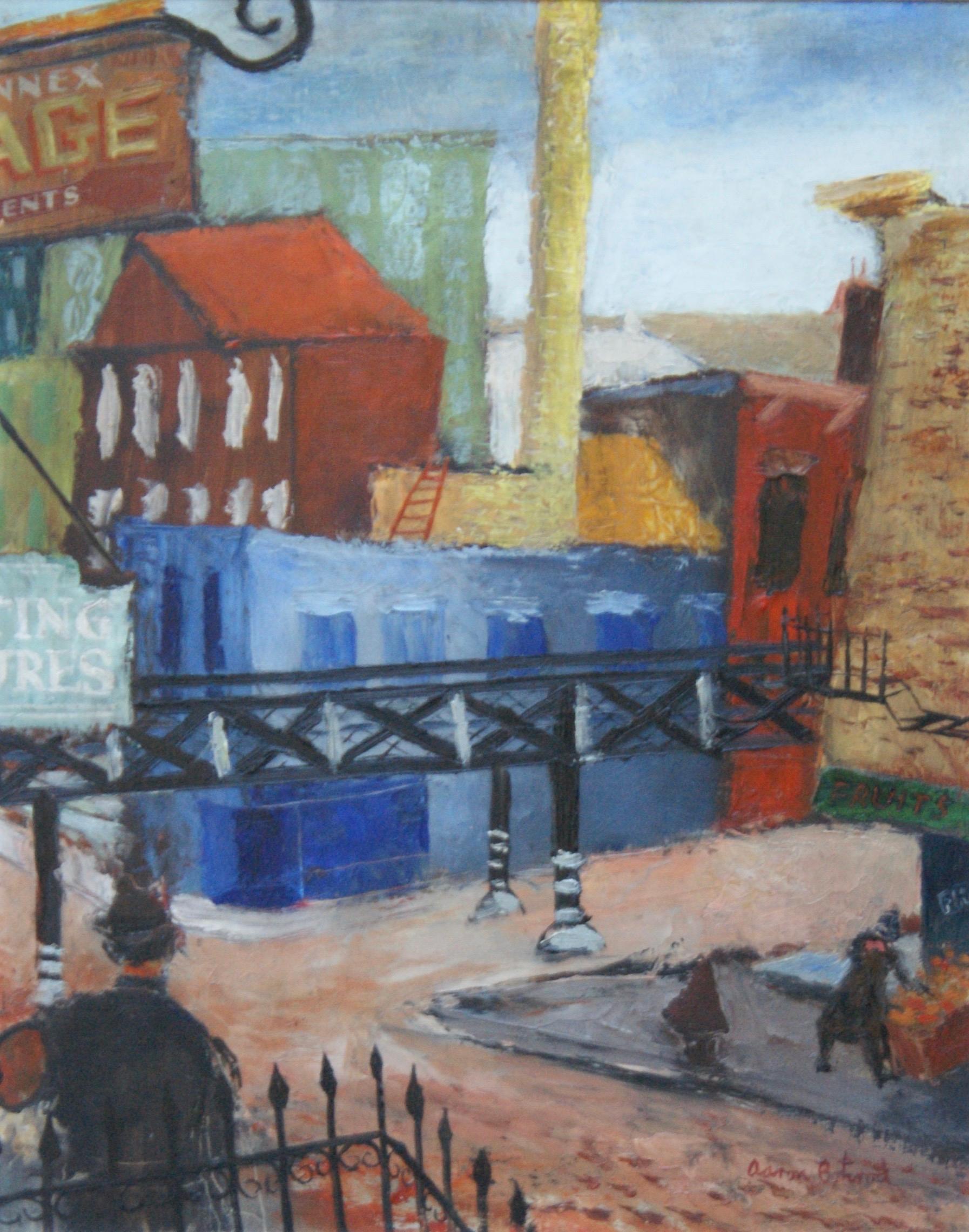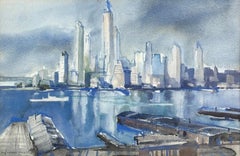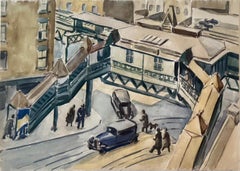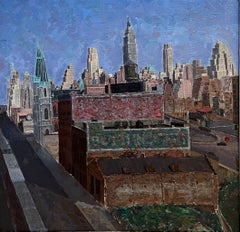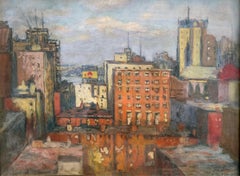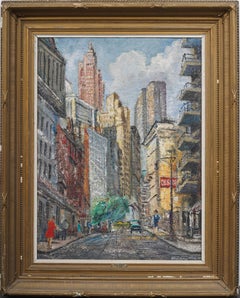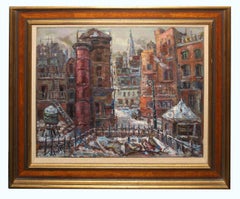Items Similar to NYC Cityscape American Scene WPA Modern Realism Mid 20th Century Architectural
Want more images or videos?
Request additional images or videos from the seller
1 of 6
Ernest FieneNYC Cityscape American Scene WPA Modern Realism Mid 20th Century Architectural1930
1930
$39,000
£29,432.23
€33,695.45
CA$55,002.93
A$60,386.36
CHF 31,503.69
MX$730,759
NOK 394,849.88
SEK 372,052.40
DKK 251,527.55
About the Item
NYC Cityscape American Scene WPA Modern Realism Mid 20th Century Architectural
Ernest Fiene (1894-1965)
Cityscape
36 x 30 inches
Oil on canvas
Signed and dated 1930. lower right
Provenance
Estate of the artist.
ACA Galleries, New York
Exhibited
New York, Frank Rehn Gallery, Changing Old New York, 1931.
New York, ACA Galleries, Ernest Fiene: Art of the City, 1925-1955, May 2-23, 1981, n.p., no. 5.
BIO
Ernest Fiene was born in Elberfeld, Germany in 1894. As a teenager, Fiene immigrated to the United States in 1912. He studied art at the National Academy of Design in New York City from 1914 to 1918, taking day classes with Thomas Maynard and evening classes with Leon Kroll. Fiene continued his studies at the Beaux-Arts Institute of Design in New York from 1916 to 1918, adding classes in printmaking at the Art Students League in 1923.
Fiene began his career as an artist in 1919 with his first exhibition of watercolors at the MacDowell Club arranged by his mentor Robert Henri. In 1923 the Whitney Studio Club mounted a large exhibition of his works. The following year he had an exhibition at the New Gallery in New York, which completely sold out all fifty-two works, including paintings, watercolors, drawings, and etchings. With the proceeds of sales from the New Gallery exhibition, Ernest Fiene and his younger brother Paul, a sculptor, built studios in Woodstock, New York in 1925.
In the early Twenties Ernest Fiene painted mostly landscapes of Woodstock and both the Ramapo and Hudson River Valleys. The first monograph from the Younger Artists Series was published on Fiene in 1922. Published in Woodstock, the series went on to include Alexander Brook, Peggy Bacon, and Yasuo Kuniyoshi. The book reproduced 1 illustration in color and another 27 reproductions in black and white. Around 1925 Fiene became fascinated with the intensity, excitement, and opportunities for color harmonies New York City offered as a subject. His paintings shifted to urban and industrial themes with architecture, industry, and transportation becoming his subjects.
By 1926 Fiene had attracted the dealer Frank K.M. Rehn, who gave him a one-man exhibition that year, which travelled to the Boston Arts Club. C.W. Kraushaar Galleries gave Fiene a one-man exhibition of urban, landscape, portrait, and still life paintings in 1927. Julianna Force, the director of the Whitney Studio Club and first director of the Whitney Museum of American Art, included two of Fiene’s paintings in a fall exhibition in 1928. The Whitney Studio Club showed Fiene’s paintings in a two-man exhibition with Glenn O. Coleman that year and acquired three of Fiene’s paintings. Also in 1928 Fiene became affiliated with Edith Halpert’s Downtown Gallery where he had an exhibition of 20 lithographs in the spring. Fiene sold his house in Woodstock in 1928 to spend more of his time in New York City.
With so many successful exhibitions, Fiene returned to Paris in 1928-29 where he rented Jules Pascin's studio and studied at the Académie de la Grande Chaumière. In France, Fiene painted both landscape and urban subjects developed from ideas influenced by Cubist geometry and the use of flat areas of broad color. Upon returning to New York in 1930, Fiene used this new approach to continue to paint New York skyscraper and waterfront subjects, as well as to begin a series of paintings on changing old New York based on the excavations for Radio City Music Hall and the construction of the Empire State Building. Frank K.M. Rehn Galleries exhibited this series, titled “Changing Old New York,” in 1931. Fiene also has solo exhibitions at Rehn Galleries in 1930 and 1932. Fiene’s oil paintings are exhibited at the Chicago Arts Club in 1930 as well.
Fiene was included in the Museum of Modern Art’s exhibition Painting and Sculpture by Living Americans in December of 1931. Visiting New York, Henri Matisse saw the exhibition and called Fiene’s Razing Buildings, West 49th Street the finest painting he had seen in New York. Fiene had two mural studies from his Mechanical Progress series exhibited at the Museum of Modern Art’s exhibition Murals by American Painters and Photographers in 1932. Fiene sent View from my Window which depicts Fiene working on a lithograph stone while looking out his window to the newly completed Empire State Building to the Carnegie International in 1931. In 1932 Fiene participated in the first Biennial of American Painting at the Whitney Museum and his prints were included in exhibitions at the Downtown Gallery and the Wehye Gallery. In the same year, Fiene was awarded a Guggenheim fellowship to further study mural painting in Florence, Italy.
On his return from Italy in 1933 Fiene re-engaged himself in New York City life and won several public and private mural projects. Fiene resumed his active exhibition schedule, participating in two group exhibitions at the Whitney Museum and a one-man exhibition of recent paintings at the Downtown Gallery in January 1934. In 1933 he purchased a farm in Southbury, Connecticut, which added Connecticut scenes to his landscape subjects. This was also the year Fiene began to spend summers on Monhegan Island, Maine, where he painted seascapes, harbor scenes, and still lifes.
Fiene’s landscape paintings attracted numerous commissions as part of the American Scene movement. Through the fall and winter of 1935-36, Fiene took an extended sketching trip through the urban, industrial, and farming areas of Pennsylvania and West Virginia. Most of the twenty-four Pennsylvania urban and rural paintings from this trip were featured in an exhibition held at the First National Bank in Pittsburgh in October of 1937 by the Pittsburgh Commission for Industrial Expansion. Fiene said of these works that he formed rhythm, opportunity for space and color, and integrity in the Pennsylvania mill and furnace paintings. Fiene received the silver medal for one of the Pittsburgh paintings titled Frosty Morning at the Art Institute of Chicago in 1937.
The Colorado Springs Fine Arts Center invited Fiene to spend the summer of 1935 teaching there. He accepted and fit in painting trips through Colorado and New Mexico, including Taos and Santa Fe. In 1935, the Arts Center had an exhibition of his oils and watercolors. In August of that year the Denver Art Museum has an exhibition of thirty paintings and watercolors and purchased the painting Connecticut Hills, Winter. The Denver Art Museum held an exhibition of Fiene’s lithographs in 1937.
In 1937 Fiene also completed a mural for the Post Office in Canton, Massachusetts. In 1938 he completed a large four panel mural for the Department of the Interior Building in Washington, DC. Fiene's largest mural project was for the High School of Needle Trades, begun in 1937 and unveiled in 1940 after two and a half years of constant work.
Fiene had his largest exhibitions in 1940 with a total of 53 paintings and watercolors at his new dealer Associated American Artists. The exhibition includes Razing the Old Post Office, a New York subject which received a prize at the Carnegie International in 1939; Frosty Morning which received silver medal at the Art Institute of Chicago in 1937, and Spring Evening which received the W.A. Clark prize from the Corcoran Gallery in 1939.
Ernest Fiene participated in the American Tobacco Company’s series of tobacco paintings, commissioned from 1940 to 1942 by the company’s president George Washington Hill. American Tobacco sought the best artists of the time, including Ernest Fiene, Aaron Bohrod, Thomas Hart Benton, Doris Lee, George Schreiber and Frederick Taubes, to depict the entire tobacco production, from planting and harvesting to curing and auction. The paintings, which continued to arrive at American Tobacco until 1945, were used to decorate the company’s headquarters and in advertisements. American Tobacco described the commission as “a series of paintings of the tobacco country by America’s foremost artists.”
During the war years, much of Fiene’s commission work consisted of painting various phases of industry in relation to the war, such as the trips he took to Texas and Louisiana to record the operations of the oil industry. He also recorded the making of optical instruments at Abbott Laboratories in Corning, New York. These war industry paintings were exhibited in 1944 at the Associated American Artists gallery in New York City.
As a successful artist Fiene was in demand as a teacher. Fiene taught at Westchester County Center in New York from 1930 to 1931 and at the Cooper Union in New York from 1938 to 1939. At the Art Students League he taught a well-known Saturday class from 1939 until his death in 1965. Fiene also taught at the National Academy of Design from 1959 to 1964; he was elected an Academician there in 1952.
Fiene’s dealer during the 1950s and 1960s was Midtown Galleries in New York. In 1959 Midtown gave Fiene a solo exhibition of his most recent, more abstracted New York City subjects, which received glowing reviews. Fiene enjoyed widespread respect among the community of artists in America. Elected president of the Artists Equity Association in 1953, Fiene remained that organization’s president in an honorary capacity until his death in 1965.
He maintained a long time personal correspondence with the artists George Grosz, Jules Pascin, Gaston Lachaise, Stuart Davis, and Thomas Hart Benton.
Ernest Fiene’s work is included in numerous public collections, including the Brooklyn Museum; Art Institute of Chicago; Cleveland Museum of Art; Denver Art Museum; Los Angeles County Museum of Art; Museum of Fine Arts, Boston; Pennsylvania Academy of the Fine Arts; and the Whitney Museum of American Art.
- Creator:Ernest Fiene (1894-1965, American)
- Creation Year:1930
- Dimensions:Height: 45 in (114.3 cm)Width: 39 in (99.06 cm)
- Medium:
- Movement & Style:
- Period:
- Condition:The painting is in very good condition. The gold leaf on the frame could use a touch up.
- Gallery Location:New York, NY
- Reference Number:1stDibs: LU1156213004012
About the Seller
5.0
Gold Seller
Premium sellers maintaining a 4.3+ rating and 24-hour response times
Established in 2008
1stDibs seller since 2019
195 sales on 1stDibs
Typical response time: <1 hour
- ShippingRetrieving quote...Shipping from: New York, NY
- Return Policy
Authenticity Guarantee
In the unlikely event there’s an issue with an item’s authenticity, contact us within 1 year for a full refund. DetailsMoney-Back Guarantee
If your item is not as described, is damaged in transit, or does not arrive, contact us within 7 days for a full refund. Details24-Hour Cancellation
You have a 24-hour grace period in which to reconsider your purchase, with no questions asked.Vetted Professional Sellers
Our world-class sellers must adhere to strict standards for service and quality, maintaining the integrity of our listings.Price-Match Guarantee
If you find that a seller listed the same item for a lower price elsewhere, we’ll match it.Trusted Global Delivery
Our best-in-class carrier network provides specialized shipping options worldwide, including custom delivery.More From This Seller
View All"6th Avenue El" American Scene Social Realism Mid-20th Century New York City
By Ernest Fiene
Located in New York, NY
"6th Avenue El" American Scene Social Realism Mid-20th Century New York City
Ernest Fiene (1894-1965)
"6th Avenue El"
12 1/4 x 14 1/4
Oil on canvas board, c. 1940s
Signed lower righ...
Category
1940s American Modern Figurative Paintings
Materials
Oil, Board
"Industrial Cityscape, Chicago" WPA Modernism Mid-Century Cityscape 20th Century
By Aaron Bohrod
Located in New York, NY
"Industrial Cityscape, Chicago" WPA Modernism Mid-Century Cityscape 20th Century
Aaron Bohrod (American 1907 – 1992)
Industrial Cityscape
20 x 16 inches
Oil on board
Signed lower ri...
Category
1930s American Modern Landscape Paintings
Materials
Oil, Board
NYC Cityscape American Scene Social Realism Mid-Century
By Max Arthur Cohn
Located in New York, NY
NYC Cityscape American Scene Social Realism Mid-Century
Max Arthur Cohn (1903-1998)
New York City Skyline
14 x 21 1/2 inches
Watercolor on paper, c. 1...
Category
1930s American Modern Figurative Drawings and Watercolors
Materials
Paper, Watercolor
6th Avenue El at 8th St NYC Cityscape American Scene Social Realism Mid-Century
By Max Arthur Cohn
Located in New York, NY
6th Avenue El at 8th St NYC Cityscape American Scene Social Realism Mid-Century
Max Arthur Cohn (1903-1998)
6th Avenue El at 8th Street
13 x 18 inches
Watercolor on paper, c. 1930
...
Category
1930s American Modern Figurative Drawings and Watercolors
Materials
Paper, Watercolor
"Abstract Cityscape" NYC Early 20th Century American Scene Social Realism Ashcan
By Abraham Walkowitz
Located in New York, NY
"Abstract Cityscape" NYC Early 20th Century American Scene Social Realism Ashcan
Abraham Walkowitz (American, 1878-1965)
Abstract Cityscape
Sight: 6 1/4' x 8 1/2 inches
Mixed media...
Category
1910s Abstract Landscape Drawings and Watercolors
Materials
Paper, Mixed Media
Cityscape Mid-20th Century Modern Social Realism American Scene Regionalism WPA
Located in New York, NY
Cityscape Mid-20th Century Modern Social Realism American Scene Regionalism WPA
Samuel Thal (1903 to 1964)
"Cityscene"
12 x 16 inches
Oil on board, c. 1940s
Signed verso
Framed: 19...
Category
1940s American Modern Figurative Paintings
Materials
Board, Oil
You May Also Like
"Manhattan Looking East, " Herman Rose, WPA New York City View from Midtown
By Herman Rose
Located in New York, NY
Herman Rose (1909 - 2007)
Manhattan Looking East (View from Midtown), 1952-54
Oil on canvas
26 x 28 inches
Signed lower right
Fairfield Porter wrote an essay in ArtNews on this exact painting in 1955. Please inquire for a copy of the article.
Literature:
Fairfield Porter, "Herman Rose Paints a Picture," ArtNews, April 1955 Volume 54, Number 2, illustrated.
Herman Rose was best known for his depictions of cityscapes of New York City. Herman Rappaport was born in Brooklyn, New York. in 1909. Herman Rose was the professional pseudonym of Herman Rappaport. Originally trained as a draftsman and studied at the National Academy of Design from 1927 to 1929, he was later employed by the Works Progress Administration's Murals Division under Arshile Gorky from 1934 until 1939. In 1939, after experimenting with a variety of contemporary expressionistic styles, Rose decided to paint from life. Working mostly in East New York and East Canarsie in Brooklyn, and in Manhattan, Rose began to paint roof tops and street scenes.
Rappaport began using the name Herman Rose when he held his first solo art exhibition in 1946 at the Charles Egan Gallery in New York City. Although he initially began as an Expressionistic painter, he became known for small, light-filled Impressionist paintings of still life, cityscapes and skies by the early 1950s. His paintings and images were often composed of very small dabs of paint and tiny, blurry "squares," which combined to create the image on canvas, his favorite medium. Often described as a "lyrical painter" Rose's work "interpreted traditional subjects: landscape, still life and the figure like the Post-Impressionists from whom he developed his own style, Rose built up forms from distinct touches of color that don't entirely blend in the viewer's eye. This gives his surfaces an active quality that flattens forms, one of the great lessons of modernism."
Herman Rose's work received official recognition when Ms. Dorothy Miller of Museum of Modern Art (MoMA) included his work in an exhibition called, "15 Americans," alongside work by Clyfford Still, Mark Rothko and Jackson Pollock.
New York Times art critic Hilton Kramer wrote of Rose's work in 1981, "{he} must surely be counted among the most beautiful works anyone has produced in this challenging medium for many years." The Art in America art critic Lawrence Campbell...
Category
1950s American Modern Landscape Paintings
Materials
Canvas, Oil
New York Skyline the West Side with Hudson River - Vintage New York
By Frank S. Hermann
Located in Miami, FL
Rooftop view of the upper West Side Manhattan as it looked in the 1930s. There is a rough indication of a billboard and a glimpse of the Hudson River. The cluster of buildings depic...
Category
1930s American Impressionist Landscape Paintings
Materials
Oil, Gouache, Board
Antique American Modernist Large New York Cityscape Framed Street Scene Painting
Located in Buffalo, NY
Antique American modernist street scene painting. Oil on canvas. Signed. In excellent original condition. Handsomely framed in a late 19th century fluted cove giltwood molding. E...
Category
1940s Modern Landscape Paintings
Materials
Canvas, Oil
Lower Manhattan Cityscape American Artist WPA Era NY School c. 1930 Henry Ensol
Located in Buffalo, NY
An original modern 1930's oil painting by WPA era American artist Henry Ensol. This work comes in a period frame likely original to the piece.
Category
1930s American Modern Landscape Paintings
Materials
Canvas, Oil
A Dynamic Mid-Century Modern Manhattan Scene, New York City by Francis Chapin
By Francis Chapin
Located in Chicago, IL
A Large, Dynamic 1950s Mid-Century Modern Watercolor of Lower Manhattan, New York City by Noted Chicago Artist, Francis Chapin (Am. 1899-1965). The image is watercolor, pastel and c...
Category
Mid-20th Century American Modern Landscape Paintings
Materials
Watercolor, Archival Paper, Charcoal, Pastel
'Financial District', New York City — American Modernism
By Howard Norton Cook
Located in Myrtle Beach, SC
Howard Cook, 'Financial District', lithograph, 1931, edition 75, Duffy 155. A fine, richly-inked impression, on cream wove paper, the full sheet with wide margins (2 3/4 to 5 5/8 inches), in excellent condition. Image size 13 5/16 x 10 3/8 inches (338 x 264 mm); sheet size 23 x 16 inches (584 x 406 mm). Matted to museum standards, unframed.
Literature: 'American Master Prints from the Betty and Douglas Duffy Collection', the Trust for Museum Exhibitions, Washington, D.C., 1987.
Collections: Crystal Bridges Museum of American Art, Library of Congress, Metropolitan Museum of Art, Philadelphia Museum of Art, Smithsonian American Art Museum.
ABOUT THE ARTIST
Howard Norton Cook (1901-1980) was one of the best-known of the second generation of artists who moved to Taos. A native of Massachusetts, he studied at the Art Students League in New York City and at the Woodstock Art Colony. Beginning his association with Taos in 1926, he became a resident of the community in the 1930s. During his career, he received two Guggenheim Fellowships and was elected an Academician in the National Academy of Design. He earned a national reputation as a painter, muralist, and printmaker.
Cook’s work in the print mediums received acclaim early in his career with one-person exhibitions at the Denver Art Museum (1927) and the Museum of New Mexico (1928). He received numerous honors and awards over the years, including selection in best-of-the-year exhibitions sponsored by the American Institute of Graphics Arts, the Brooklyn Museum, the Society of American Etchers, and the Philadelphia Print Club. His first Guggenheim Fellowship took him to Taxco, Mexico in 1932 and 1933; his second in the following year enabled him to travel through the American South and Southwest.
Cook painted murals for the Public Works of Art Project in 1933 and the Treasury Departments Art Program in 1935. The latter project, completed in Pittsburgh, received a Gold Medal from the Architectural League of New York. One of his most acclaimed commissions was a mural in the San Antonio Post Office in 1937.
He and Barbara Latham settled in Talpa, south of Taos, in 1938 and remained there for over three decades. Cook volunteered in World War II as an Artist War Correspondent for the US Navy, where he was deployed in the Pacific. In 1943 he was appointed Leader of a War Art Unit...
Category
1930s American Modern Figurative Prints
Materials
Lithograph
More Ways To Browse
Modern Architecture Art
Mid Century Cityscape
Skyscraper New York
Matisse Exhibition
Pascin Jules
Radio City Music Hall
Radio City Music Hall Vintage
Empire State Building Vintage
Mid Century Nyc
Monhegan Island
French Architecture House Design Lithograph
Henri Studios
Mid Century Modern Winter Scene
Realism Cityscape
Thomas Hart Benton Signed Lithograph
Thomas Day
Nyc Cityscape Paintings
W Clark Mid Century Painting
